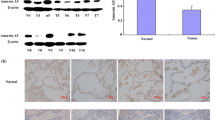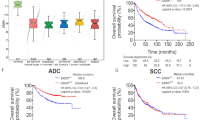Abstract
The purposes of this study were to investigate the effects of the SASH1gene on the growth, proliferation, apoptosis, invasiveness, and metastatic potential of lung cancer cells and explore the potential use of SASH1 for the treatment of human lung cancer. The SASH1 gene was cloned into the pcDNA3.1 eukaryotic expression vector, and SASH1 shRNA were designed and constructed. The resulting constructs were transfected into A549 human lung cancer cells, and the changes in the relevant biological characteristics of the cells overexpressing SASH1 and cells with downregulated expression of SASH1 were analyzed using the MTT assay, transwell invasion assay, and flow cytometry. The effects of the SASH1 gene on the expression of cyclin D1, Bcl-2, and MMP-2/9 were also concurrently examined. In the A549 cells from the pcDNA3.1-SASH1 transfected group, cell viability, proliferation, and migration were significantly reduced compared to the control cells (p = 0.039, p = 0.013), and a cell cycle arrest in G1 was observed. The A549 cells transfected with the SASH1 shRNA demonstrated significantly higher cell viabilities, proliferation, and migration compared to the control cells (p = 0.012, p = 0.045). Additionally, the percentage of A549 cells undergoing apoptosis was significantly higher in the pcDNA3.1-SASH1 transfected cells and significantly lower in the SASH1 shRNA transfected cells compared to the control cells (p = 0.010, p = 0.000). The cyclin D1, Bcl-2, and MMP-9/2 protein expression levels were significantly lower in the pcDNA3.1-SASH1-transfected cells and were significantly higher in the SASH1 shRNA-transfected cells than that in the control cells. The SASH1 gene may inhibit A549 cell growth and proliferation as well as promote cellular apoptosis. The overexpression of the SASH1 gene may also be related to the decreased migration of A549 human lung cancer cells.






Similar content being viewed by others
References
Yoo NJ, Park SW, Lee SH. Mutational analysis of tumour suppressor gene NF2 in common solid cancers and acute leukaemias. Pathology. 2012;44(1):29–32.
Prager GW, Poettler M, Unseld M, Zielinski CC. Angiogenesis in cancer: anti-VEGF escape mechanisms. Transl Lung Cancer Res. 2012;1(1):14–25.
Ma C, Wei S, Song Y. T790M and acquired resistance of EGFR TKI: a literature review of clinical reports. J Thorac Dis. 2011;3(1):10–8.
Gu X, Ma C, Yuan D, Song Y. Circulating soluble intercellular adhesion molecule-1 in lung cancer: a systematic review. Transl Lung Cancer Res. 2012;1(1):36–44.
Yang L, Li Y, Ling X, Liu L, Liu B, Xu K, Bin X, Ji W, Lu J. A common genetic variant (97906C >A) of DAB2IP/AIP1 is associated with an increased risk and early onset of lung cancer in Chinese males. PLoS One. 2011;6(10):e26944.
Metro G, Crinò L. Advances on EGFR mutation for lung cancer. Transl Lung Cancer Res. 2012;1(1):5–13.
Naguib A, Cooke JC, Happerfield L, Kerr L, Gay LJ, Luben RN, Ball RY, Mitrou PN, McTaggart A, Arends MJ. Alterations in PTEN and PIK3CA in colorectal cancers in the EPIC Norfolk study: associations with clinicopathological and dietary factors. BMC Cancer. 2011;11:123.
Pustisek N, Situm M. UV-radiation, apoptosis and skin. Coll Antropol. 2011;35 Suppl 2:339–41.
Marcel V, Dichtel-Danjoy ML, Sagne C, Hafsi H, Ma D, Ortiz-Cuaran S, Olivier M, Hall J, Mollereau B, Hainaut P, Bourdon JC. Biological functions of p53 isoforms through evolution: lessons from animal and cellular models. Cell Death Differ. 2011;18(12):1815–24.
Zeller C, Hinzmann B, Seitz S, Prokoph H, Burkhard-Goettges E, Fischer J, Jandrig B, Schwarz LE, Rosenthal A, Scherneck S. SASH1: a candidate tumor suppressor gene on chromosome 6q24.3 is downregulated in breast cancer. Oncogene. 2003;22(19):2972–83.
Martini M, Gnann A, Scheikl D, Holzmann B, Janssen KP. The candidate tumor suppressor SASH1 interacts with the actin cytoskeleton and stimulates cell-matrix adhesion. Int J Biochem Cell Biol. 2011;43(11):1630–40.
Rimkus C, Martini M, Friederichs J, Rosenberg R, Doll D, Siewert JR, Holzmann B, Janssen KP. Prognostic significance of downregulated expression of the candidate tumour suppressor gene SASH1 in colon cancer. Br J Cancer. 2006;95(10):1419–23.
Aviv T, Lin Z, Lau S, Rendl LM, Sicheri F, Smibert CA. The RNA-binding SAM domain of Smaug defines a new family of post-transcriptional regulators. Nat Struct Biol. 2003;10(8):614–21.
Koch CA, Anderson D, Moran MF, Ellis C, Pawson T. SH2 and SH3 domains: elements that control interactions of cytoplasmic signaling proteins. Science. 1991;252(5006):668–74.
Claudio JO, Zhu YX, Benn SJ, Shukla AH, McGlade CJ, Falcioni N, Stewart AK. HACS1 encodes a novel SH3-SAM adaptor protein differentially expressed in normal and malignant hematopoietic cells. Oncogene. 2001;20(38):5373–7.
Kim CA, Gingery M, Pilpa RM, Bowie JU. The SAM domain of polyhomeotic forms a helical polymer. Nat Struct Biol. 2002;9(6):453–7.
Kuribayashi K, Nakamura K, Tanaka M, Sato T, Kato J, Sasaki K, Takimoto R, Kogawa K, Terui T, Takayama T, Onuma T, Matsunaga T, Niitsu Y. Essential role of protein kinase C zeta in transducing a motility signal induced by superoxide and a chemotactic peptide, fMLP. J Cell Biol. 2007;176(7):1049–60.
Kang BY, Tsoi S, Zhu S, Su S, Kay HH. Differential gene expression profiling in HELLP syndrome placentas. Reprod Sci. 2008;15(3):285–94.
Das SK, Bhutia SK, Kegelman TP, Peachy L, Oyesanya RA, Dasgupta S, Sokhi UK, Azab B, Dash R, Quinn BA, Kim K, Barral PM, Su ZZ, Boukerche H, Sarkar D, Fisher PB. MDA-9/syntenin: a positive gatekeeper of melanoma metastasis. Front Biosci. 2012;17:1–15.
Chetty C, Vanamala SK, Gondi CS, Dinh DH, Gujrati M, Rao JS. MMP-9 induces CD44 cleavage and CD44 mediated cell migration in glioblastoma xenograft cells. Cell Signal. 2012;24(2):549–59.
Sen T, Chatterjee A. Epigallocatechin-3-gallate (EGCG) downregulates EGF-induced MMP-9 in breast cancer cells: involvement of integrin receptor alpha5beta1 in the process. Eur J Nutr. 2011;50(6):465–78.
Shen KH, Hung SH, Yin LT, Huang CS, Chao CH, Liu CL, Shih YW. Acacetin, a flavonoid, inhibits the invasion and migration of human prostate cancer DU145 cells via inactivation of the p38 MAPK signaling pathway. Mol Cell Biochem. 2010;333(1–2):279–91.
Chen YY, Chiang SY, Lin JG, Ma YS, Liao CL, Weng SW, Lai TY, Chung JG. Emodin, aloe-emodin and rhein inhibit migration and invasion in human tongue cancer SCC-4 cells through the inhibition of gene expression of matrix metalloproteinase-9. Int J Oncol. 2010;36(5):1113–20.
Kim A, Kim MJ, Yang Y, Kim JW, Yeom YI, Lim JS. Suppression of NF-kappaB activity by NDRG2 expression attenuates the invasive potential of highly malignant tumor cells. Carcinogenesis. 2009;30(6):927–36.
Bausero MA, Bharti A, Page DT, Perez KD, Eng JW, Ordonez SL, Asea EE, Jantschitsch C, Kindas-Muegge I, Ciocca D, Asea A. Silencing the hsp25 gene eliminates migration capability of the highly metastatic murine 4T1 breast adenocarcinoma cell. Tumour Biol. 2006;27(1):17–26.
Yang X, Zhang P, Ma Q, Kong L, Li Y, Liu B, Lei D. EMMPRIN contributes to the in vitro invasion of human salivary adenoid. Oncol Rep. 2011. doi:10.3892/or.2011.1606.
Kanno T, Kamba T, Yamasaki T, Shibasaki N, Saito R, Terada N, Toda Y, Mikami Y, Inoue T, Kanematsu A, Nishiyama H, Ogawa O, Nakamura E. JunB promotes cell invasion and angiogenesis in VHL-defective renal cell carcinoma. Oncogene. 2011. doi:10.1038/onc.2011.1475.
Author information
Authors and Affiliations
Corresponding author
Additional information
En-guo Chen and Yanfan Chen contributed equally to this study.
The authors have no commercial, proprietary, or financial interest in the products or companies described in this article.
Rights and permissions
About this article
Cite this article
Chen, Eg., Chen, Y., Dong, Ll. et al. Effects of SASH1 on lung cancer cell proliferation, apoptosis, and invasion in vitro. Tumor Biol. 33, 1393–1401 (2012). https://doi.org/10.1007/s13277-012-0387-2
Received:
Accepted:
Published:
Issue Date:
DOI: https://doi.org/10.1007/s13277-012-0387-2




